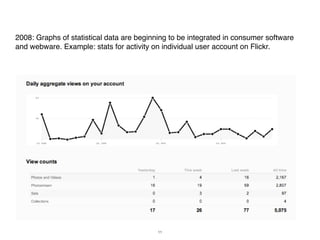Intro to CAA 2012 session "Visualization as a Method in Art History"
- 1. Information Visualization as a Research Method in Art History CAA 2012 session Introduction by Lev Manovich 1
- 2. visualization timeline: - development of key techniques: by 1830s - scientific visualization: 1988- - information visualization: 1998- - artistic visualization: 2001- - visualization is featured in Design and Elastic Mind at MOMA: 2008 - Obama campaign site uses sophisticated visualization: 2008 - visualization become ubiquitous (you have to include in your social web site): 2011 2
- 3. Aaron Koblin, Flight Patterns. 2005. 3
- 4. Alex Dragulescki (UCSD). Spam Architecture. 2005. 4
- 5. Visualization of books flow in Seattle Public Library. Artist: George Legrady, UCSB 5
- 6. IAC Building, NYC: outside view; the lobby with the visualization showing global users accessing web properties owned by IAC. Dynamic visualization as a new logo of a company/institution -- representation of dynamic process rather than static identity. 6
- 7. New York Times building: visualization of text drawn from NYT archives. Artists: Ben Rubin and Mark Hanson. 7
- 8. 8
- 9. 9
- 10. 10
- 11. 2008: Graphs of statistical data are beginning to be integrated in consumer software and webware. Example: stats for activity on individual user account on Flickr. 11
- 12. 2009: stats for videos on YouTube. 12
- 13. 2009: stats for videos on YouTube. 13
- 14. the development of “cultural visualization”: graphing cultural patterns 14
- 15. History Flow 15
- 16. History Flow 16
- 18. Lee Byron. Personal listening history using last.fm data. 18
- 19. Blue pictures are by locals. Red pictures are by tourists. Yellow pictures might be by either. Base map © OpenStreetMap, CC-BY-SA 19 Visualization by Eric Fischer
- 20. Mapping global culture using “digital traces.” Google Trends, 2007. 20
- 22. visualization + big cultural data: NEH Offfice of Digital Humanities (created 3/2008) Humanities High Performance Computing initiative: “Humanities High-Performance Computing (HHPC) refers to the use of high- performance machines for humanities and social science projects. Currently, only a small number of humanities scholars are taking advantage of high-performance computing. But just as the sciences have, over time, begun to tap the enormous potential of HPC, the humanities are beginning to as well. Humanities scholars often deal with large sets of unstructured data. This might take the form of historical newspapers, books, election data, archaeological fragments, audio or video contents, or a host of others. HHPC offers the humanist opportunities to sort through, mine, and better understand and visualize this data.” 22
- 23. January 2009: NEH and NSF announce DIGGING INTO DATA CHALLENGE. Grant amounts: up to 300K USD. "The creation of vast quantities of Internet accessible digital data and the development of techniques for large-scale data analysis and visualization have led to remarkable new discoveries in genetics, astronomy, and other fields, and— importantly—connections between academic disciplinary areas." "With books, newspapers, journals, films, artworks, and sound recordings being digitized on a massive scale, it is possible to apply data analysis techniques to large collections of diverse cultural heritage resources as well as scientific data. How might these techniques help scholars use these materials to ask new questions about and gain new insights into our world?" 23
- 24. Usually visualizations of cultural data do not show the actual objects (texts, images, etc.) but only show patterns in metadata (dates, names, text features, geo locations). In our Software Studies Initiative at UCSD (softwarestudies.com) we developed tools to visualize the actual large collections. Images can be sorted in a variety of ways using both existing metadata and automatic measurements of their visual attributes.
- 26. imageplot of 1 million manga pages organized by visual characteristics
- 27. Upper part of the visualization (closeup view) contains pages with full range of gray tones, and lots of texture and details Bottom right part of the visualization (closeup view) contains pages in black and white with little detail and no texture
- 28. Image plot of 393 Mark Rothko’s paintings (1927-1970). Hao Wang and Mayra Vasquez (undergraduate UCSD students). 2011. X-axis = date (year). Y-axis = average brightness (mean). Writings about Mark Rothko often emphasize the dark paintings created in the last years of his life. However, visualizing 393 paintings (1927-1970) shows that this period represents a culmination of a trend
- 29. Image plots of selected paintings by six impressionist artists. X-axis = mean saturation. Y-axis = median hue. Megan O’Rourke (undergraduate UCSD student), 2012.
- 31. our free software tools for analyzing and visualizing large image and video collections, publications and projects: softwarestudies.com































